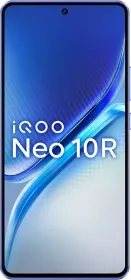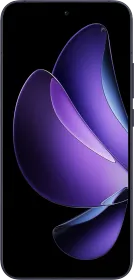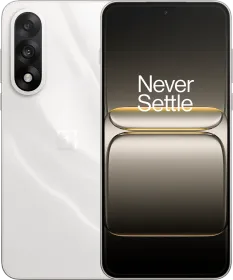The mid-range smartphone market in India is fiercely competitive, with brands like iQOO and OnePlus vying for the attention of performance enthusiasts. Two standout contenders in this segment are the iQOO Neo 10R and the OnePlus Nord 4, both priced competitively around ₹25,000–₹29,000 depending on offers.
These devices cater to users who prioritize performance, software longevity, and value for money. In this article, we’ll break down their differences across design, display, hardware, software, cameras, battery, and charging to help you decide which one suits your needs best.
Design and Build
The iQOO Neo 10R sports a sleek design with a glass front protected by Schott Xensation Up, paired with a plastic back and frame. It measures 163.7 x 75.9 x 8 mm and weighs 196 grams, but it’s made of plastic. Available in Raging Blue and MoonKnight Titanium, it offers a modern aesthetic with an IP65 rating for dust and water resistance, capable of withstanding low-pressure water jets.

In contrast, the OnePlus Nord 4 elevates the premium feel with a glass front, aluminum back, and aluminum frame. It’s slightly slimmer at 162.6 x 75 x 8 mm but marginally heavier at 199.5 grams. The aluminum build gives it a classier, more durable vibe, and it also carries an IP65 rating. Color options include Obsidian Midnight, Mercurial Silver, and Oasis Green.

Verdict: The Nord 4 wins here with its premium aluminum construction, though the Neo 10R’s lighter weight might appeal to others.
ALSO READ: iQOO Neo 10R Review: Best Phone For BGMI Gaming Under ₹30,000?
Display
The iQOO Neo 10R features a 6.78-inch AMOLED display with a 144 Hz refresh rate, HDR10+, 1200 Nits HBM, and a peak brightness of 4500 Nits. Its resolution of 1260 x 2800 pixels delivers a pixel density of ~452 ppi. It’s a panel from TCL.

The OnePlus Nord 4 counters with a 6.74-inch Fluid AMOLED display, supporting a 120 Hz refresh rate and HDR10+. It peaks at 2150 nits (1100 Nits HBM) and offers a resolution of 1240 x 2772 pixels (~450 ppi). Both displays are flat.
Verdict: It’s a draw here.
Hardware (Performance)
Under the hood, the iQOO Neo 10R is powered by the Qualcomm Snapdragon 8s Gen 3 (4 nm), featuring an octa-core CPU (1 x 3.0 GHz Cortex-X4, 4 x 2.8 GHz Cortex-A720, 3 x 2.0 GHz Cortex-A520) and Adreno 735 GPU. It comes in configurations of 8GB/128GB (UFS 3.1), 8GB/256GB, and 12GB/256GB (both UFS 4.1). However, we found the UFS 4.1 to be underperforming in our tests.

The OnePlus Nord 4 runs on the Snapdragon 7+ Gen 3 (4 nm), with an octa-core CPU (1 x 2.8 GHz Cortex-X4, 4 x 2.6 GHz Cortex-A720, 3 x 1.9 GHz Cortex-A520) and Adreno 732 GPU. Its memory options include 8GB/256GB and 12GB/256GB (all UFS 4.0).

Verdict: The Neo 10R’s Snapdragon 8s Gen 3 slightly outclasses the Nord 4’s 7+ Gen 3 in raw power, but the Nord 4 holds its own with excellent real-world performance. It’s a draw once again.
ALSO READ: Phone (3a) vs. Edge 50 Neo vs. realme P3 Pro: Which Mid-Ranger Is Best For You?
Software
The iQOO Neo 10R ships with Android 15 and Funtouch OS 15, promising 3 years of OS updates and 4 years of security patches. While functional, Funtouch OS is often criticized for bloatware and a less refined user experience. The iQOO Neo 10R comes with Circle to Search, which the Nord 4 lacks, at least at the time of writing.

The OnePlus Nord 4 launched with Android 14 and OxygenOS 15, offering 4 years of OS updates and 6 years of security updates. Having already received one update, it effectively has 3 years of OS updates remaining and 6 years of security patches. OxygenOS is widely praised for its clean, fast, and customizable interface. OnePlus also has got more AI features except Circle to Search.

Verdict: The Nord 4 dominates with longer software support and the superior OxygenOS experience, making it a better long-term investment.
Cameras
The iQOO Neo 10R’s rear setup includes a 50 MP wide sensor (f/1.8, OIS) and an 8 MP ultrawide (f/2.2), supporting 4K60 video recording. Its 32 MP front camera (f/2.45) also records in 4K.

The OnePlus Nord 4 mirrors the rear configuration with a 50 MP wide sensor (f/1.8, OIS) and an 8 MP ultrawide (f/2.2), delivering 4K60 video. However, its 16 MP selfie camera (f/2.4) is limited to 1080p, lagging behind the Neo 10R.

Verdict: The Neo 10R excels with its higher-resolution, 4K-capable front camera, while the Nord 4’s rear performance should be comparable.
ALSO READ: Galaxy AI vs. OnePlus AI: Which One is Better?
Battery and Charging
The iQOO Neo 10R boasts a massive 6,400 mAh Si/C Li-Ion battery, paired with 80W wired charging. Its capacity is a standout for heavy users. The OnePlus Nord 4 has a 5,500 mAh battery with 100W wired charging, which charges much faster than the Neo 10R.

Verdict: It’s a win for the iQOO here, but the Nord 4 is no slouch either.
Comparison Table
| iQOO Neo 10R | OnePlus Nord 4 | |
| Price (8GB/128GB) | ₹27,000 (₹25,000 with offers) | – |
| Price (8GB/256GB) | ₹29,000 | ₹29,000 (₹25,000 with offers) |
| Build | Glass front, plastic back/frame | Glass front, aluminum back/frame |
| Weight | 196g | 199.5g |
| Display | 6.78-inch AMOLED, 144Hz, 4500 nits | 6.74-inch Fluid AMOLED, 120Hz, 2150 nits |
| Chipset | Snapdragon 8s Gen 3 | Snapdragon 7+ Gen 3 |
| OS Updates | 3 years (Android 15, Funtouch OS) | 4 years (3 remaining), OxygenOS 15 |
| Security Updates | 4 years | 6 years |
| Main Camera | 50 MP (OIS) + 8 MP ultrawide | 50 MP (OIS) + 8 MP ultrawide |
| Selfie Camera | 32 MP (4K) | 16 MP (1080p) |
| Battery | 6400 mAh | 5500 mAh |
| Charging | 80W (100% in 55 min) | 100W (100% in 28 min) |
Which One Should You Buy?

For performance enthusiasts on a budget starting at ₹25,000 (with offers), both phones deliver exceptional value. The iQOO Neo 10R (8GB/128GB: ₹27,000, ₹25,000 with offers; 8GB/256GB: ₹29,000) shines with its superior battery and better selfie camera. However, the OnePlus Nord 4 (8GB/256GB: ₹29,000, ₹25,000 with offers) counters with a premium build, more storage for less, longer software support, faster charging, and the polished OxygenOS experience. Which one would you pick? Let us know in the comments below.
You can follow Smartprix on Twitter, Facebook, Instagram, and Google News. Visit smartprix.com for the most recent tech and auto news, reviews, and guides.


































